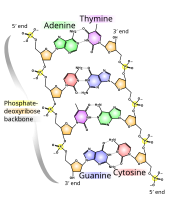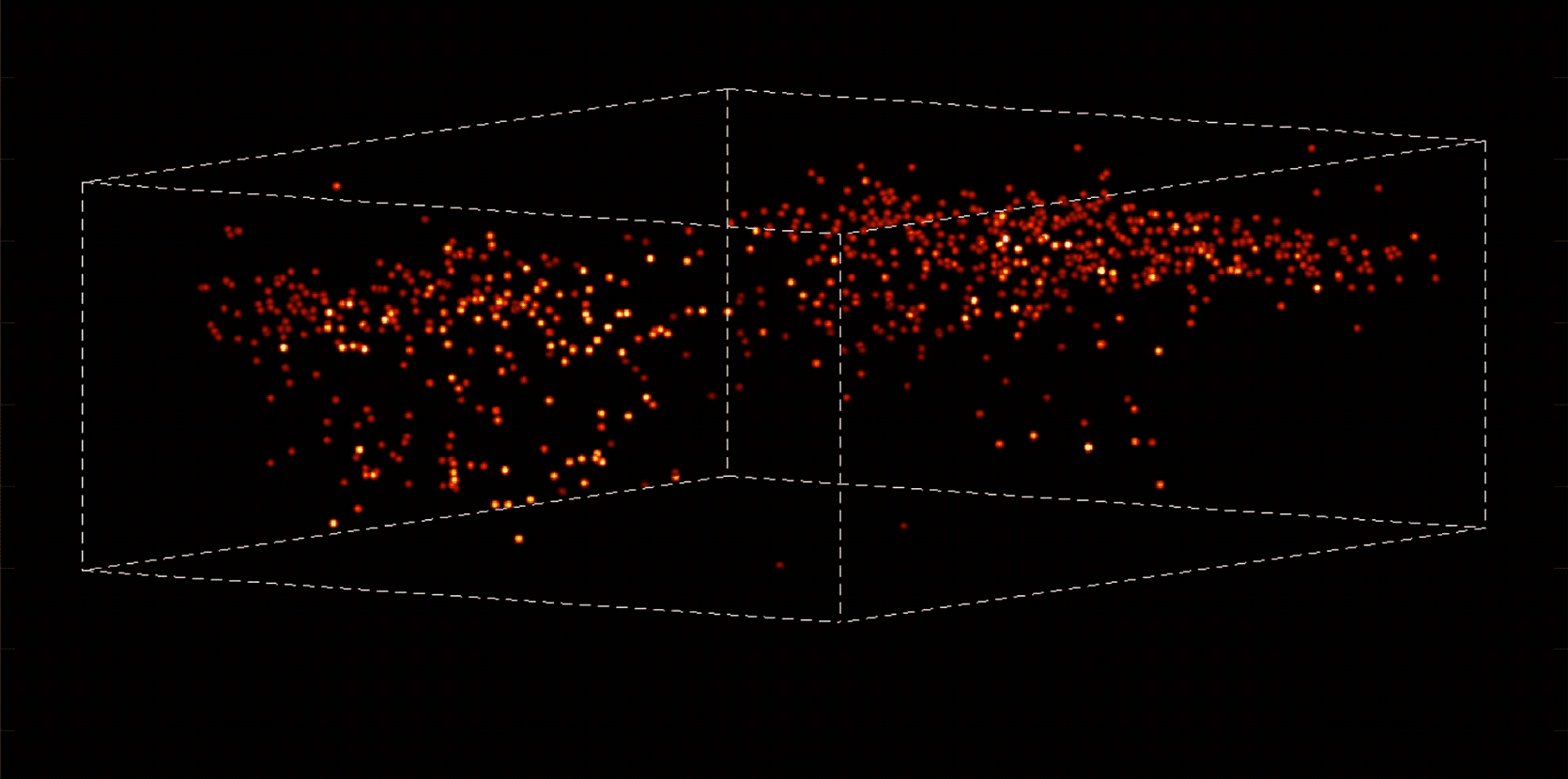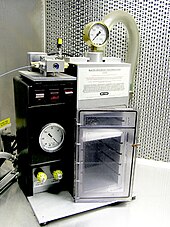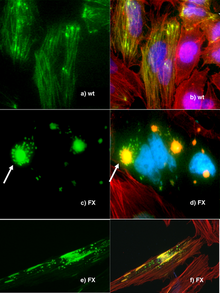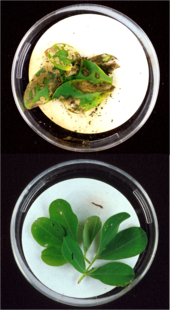From Wikipedia, the free encyclopedia
Genetic engineering, also called
genetic modification or
genetic manipulation, is the direct manipulation of an organism's
genes using
biotechnology. It is a set of
technologies
used to change the genetic makeup of cells, including the transfer of
genes within and across species boundaries to produce improved or novel
organisms. New
DNA is obtained by either isolating and copying the genetic material of interest using
recombinant DNA methods or by
artificially synthesising the DNA. A
construct is usually created and used to insert this DNA into the host organism. The first recombinant DNA molecule was made by
Paul Berg in 1972 by combining DNA from the monkey virus
SV40 with the
lambda virus. As well as inserting
genes, the process can be used to remove, or "
knock out", genes. The new DNA can be inserted randomly, or
targeted to a specific part of the
genome.
An organism that is generated through genetic engineering is
considered to be genetically modified (GM) and the resulting entity is a
genetically modified organism (GMO). The first GMO was a
bacterium generated by
Herbert Boyer and
Stanley Cohen in 1973.
Rudolf Jaenisch created the first GM animal when he inserted foreign DNA into a
mouse
in 1974. The first company to focus on genetic engineering, Genentech,
was founded in 1976 and started the production of human proteins. Genetically engineered human
insulin was produced in 1978 and insulin-producing bacteria were commercialised in 1982.
Genetically modified food has been sold since 1994, with the release of the
Flavr Savr
tomato. The Flavr Savr was engineered to have a longer shelf life, but
most current GM crops are modified to increase resistance to insects and
herbicides.
GloFish, the first GMO designed as a pet, was sold in the United States in December 2003. In 2016
salmon modified with a growth hormone were sold.
Genetic engineering has been applied in numerous fields including
research, medicine, industrial biotechnology and agriculture. In
research GMOs are used to study gene function and expression through
loss of function, gain of function, tracking and expression experiments.
By knocking out genes responsible for certain conditions it is possible
to create
animal model organisms
of human diseases. As well as producing hormones, vaccines and other
drugs genetic engineering has the potential to cure genetic diseases
through
gene therapy.
The same techniques that are used to produce drugs can also have
industrial applications such as producing enzymes for laundry detergent,
cheeses and other products.
The rise of commercialised
genetically modified crops has provided economic benefit to farmers in many different countries, but has also been the source of most of the
controversy
surrounding the technology. This has been present since its early use,
the first field trials were destroyed by anti-GM activists. Although
there is a
scientific consensus
that currently available food derived from GM crops poses no greater
risk to human health than conventional food, GM food safety is a leading
concern with critics.
Gene flow, impact on non-target organisms, control of the food supply and
intellectual property
rights have also been raised as potential issues. These concerns have
led to the development of a regulatory framework, which started in 1975.
It has led to an international treaty, the
Cartagena Protocol on Biosafety,
that was adopted in 2000. Individual countries have developed their own
regulatory systems regarding GMOs, with the most marked differences
occurring between the USA and Europe.
Overview
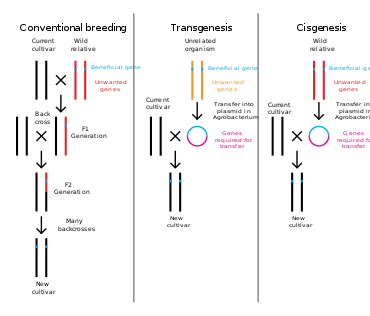
Comparison of conventional plant breeding with transgenic and cisgenic genetic modification
Genetic engineering is a process that alters the genetic structure of an organism by either removing or introducing
DNA. Unlike traditional
animal and
plant breeding, which involves doing multiple crosses and then selecting for the organism with the desired
phenotype, genetic engineering takes the
gene
directly from one organism and inserts it in the other. This is much
faster, can be used to insert any genes from any organism (even ones
from different
domains) and prevents other undesirable genes from also being added.
Genetic engineering could potentially fix severe
genetic disorders in humans by replacing the defective gene with a functioning one. It is an important tool in research that allows the function of specific genes to be studied. Drugs, vaccines and other products have been harvested from organisms engineered to produce them.
Crops have been developed that aid
food security by increasing yield, nutritional value and tolerance to environmental stresses.
The DNA can be introduced directly into the host organism or into a cell that is then
fused or
hybridised with the host. This relies on
recombinant nucleic acid
techniques to form new combinations of heritable genetic material
followed by the incorporation of that material either indirectly through
a
vector system or directly through
micro-injection, macro-injection or
micro-encapsulation.
Genetic engineering does not normally include traditional breeding,
in vitro fertilisation, induction of
polyploidy,
mutagenesis and cell fusion techniques that do not use recombinant nucleic acids or a genetically modified organism in the process. However, some broad definitions of genetic engineering include
selective breeding.
Cloning and
stem cell research, although not considered genetic engineering, are closely related and genetic engineering can be used within them.
Synthetic biology
is an emerging discipline that takes genetic engineering a step further
by introducing artificially synthesised material into an organism.
Plants, animals or micro organisms that have been changed through genetic engineering are termed
genetically modified organisms or GMOs. If genetic material from another species is added to the host, the resulting organism is called
transgenic.
If genetic material from the same species or a species that can
naturally breed with the host is used the resulting organism is called
cisgenic. If genetic engineering is used to remove genetic material from the target organism the resulting organism is termed a
knockout organism. In Europe genetic modification is
synonymous
with genetic engineering while within the United States of America and
Canada genetic modification can also be used to refer to more
conventional breeding methods.
History
Humans have altered the genomes of species for thousands of years through
selective breeding, or artificial selection as contrasted with
natural selection, and more recently through
mutagenesis. Genetic engineering as the direct manipulation of DNA by humans outside
breeding and mutations has only existed since the 1970s. The term
"genetic engineering" was first coined by
Jack Williamson in his
science fiction novel
Dragon's Island, published in 1951 – one year before DNA's role in
heredity was confirmed by
Alfred Hershey and
Martha Chase, and two years before
James Watson and
Francis Crick showed that the
DNA
molecule has a double-helix structure – though the general concept of
direct genetic manipulation was explored in rudimentary form in
Stanley G. Weinbaum's 1936 science fiction story
Proteus Island.
In 1972,
Paul Berg created the first
recombinant DNA molecules by combining DNA from the monkey virus
SV40 with that of the
lambda virus. In 1973
Herbert Boyer and
Stanley Cohen created the first
transgenic organism by inserting
antibiotic resistance genes into the
plasmid of an
Escherichia coli bacterium. A year later
Rudolf Jaenisch created a
transgenic mouse by introducing foreign DNA into its embryo, making it the world’s first
transgenic animal.
These achievements led to concerns in the scientific community about
potential risks from genetic engineering, which were first discussed in
depth at the
Asilomar Conference
in 1975. One of the main recommendations from this meeting was that
government oversight of recombinant DNA research should be established
until the technology was deemed safe.
In 1976
Genentech, the first genetic engineering company, was founded by Herbert Boyer and
Robert Swanson and a year later the company produced a human protein (
somatostatin) in
E.coli. Genentech announced the production of genetically engineered human
insulin in 1978. In 1980, the
U.S. Supreme Court in the
Diamond v. Chakrabarty case ruled that genetically altered life could be patented. The
insulin produced by bacteria was approved for release by the
Food and Drug Administration (FDA) in 1982.
In 1983, a biotech company, Advanced Genetic Sciences (AGS)
applied for U.S. government authorisation to perform field tests with
the
ice-minus strain of
Pseudomonas syringae
to protect crops from frost, but environmental groups and protestors
delayed the field tests for four years with legal challenges. In 1987, the ice-minus strain of
P. syringae became the first
genetically modified organism (GMO) to be released into the environment when a strawberry field and a potato field in California were sprayed with it.
Both test fields were attacked by activist groups the night before the
tests occurred: "The world's first trial site attracted the world's
first field trasher".
The first field trials of
genetically engineered plants occurred in France and the USA in 1986, tobacco plants were engineered to be resistant to
herbicides.
The People’s Republic of China was the first country to commercialise
transgenic plants, introducing a virus-resistant tobacco in 1992. In 1994
Calgene attained approval to commercially release the first
genetically modified food, the
Flavr Savr, a tomato engineered to have a longer shelf life. In 1994, the European Union approved tobacco engineered to be resistant to the herbicide
bromoxynil, making it the first genetically engineered crop commercialised in Europe. In 1995,
Bt Potato was approved safe by the
Environmental Protection Agency, after having been approved by the FDA, making it the first pesticide producing crop to be approved in the USA.
In 2009 11 transgenic crops were grown commercially in 25 countries,
the largest of which by area grown were the USA, Brazil, Argentina,
India, Canada, China, Paraguay and South Africa.
In 2010, scientists at the
J. Craig Venter Institute created the first
synthetic genome and inserted it into an empty bacterial cell. The resulting bacterium, named
Mycoplasma laboratorium, could
replicate and produce proteins. Four years later this was taken a step further when a bacterium was developed that replicated a
plasmid containing a unique
base pair, creating the first organism engineered to use an expanded genetic alphabet. In 2012,
Jennifer Doudna and
Emmanuelle Charpentier collaborated to develop the
CRISPR/Cas9 system, a technique which can be used to easily and specifically alter the genome of almost any organism.
Process
Creating a GMO is a multi-step process. Genetic engineers must first
choose what gene they wish to insert into the organism. This is driven
by what the aim is for the resultant organism and is built on earlier
research.
Genetic screens
can be carried out to determine potential genes and further tests then
used to identify the best candidates. The development of
microarrays,
transcriptomics and
genome sequencing has made it much easier to find suitable genes.
Luck also plays its part; the round-up ready gene was discovered after
scientists noticed a bacterium thriving in the presence of the
herbicide.
Gene isolation and cloning
The next step is to isolate the candidate gene. The
cell containing the gene is opened and the DNA is purified. The gene is separated by using
restriction enzymes to cut the DNA into fragments or
polymerase chain reaction (PCR) to amplify up the gene segment. These segments can then be extracted through
gel electrophoresis. If the chosen gene or the donor organism's
genome has been well studied it may already be accessible from a
genetic library. If the
DNA sequence is known, but no copies of the gene are available, it can also be
artificially synthesised. Once isolated the gene is
ligated into a
plasmid
that is then inserted into a bacterium. The plasmid is replicated when
the bacteria divide, ensuring unlimited copies of the gene are
available.
Before the gene is inserted into the target organism it must be combined with other genetic elements. These include a
promoter and
terminator region, which initiate and end
transcription. A
selectable marker gene is added, which in most cases confers
antibiotic resistance,
so researchers can easily determine which cells have been successfully
transformed. The gene can also be modified at this stage for better
expression or effectiveness. These manipulations are carried out using
recombinant DNA techniques, such as
restriction digests, ligations and molecular cloning.
Inserting DNA into the host genome
A gene gun uses biolistics to insert DNA into plant tissue
There are a number of techniques available for inserting the gene into the host genome. Some bacteria can naturally
take up foreign DNA. This ability can be induced in other bacteria via stress (e.g.
thermal
or electric shock), which increases the cell membrane's permeability to
DNA; up-taken DNA can either integrate with the genome or exist as
extrachromosomal DNA. DNA is generally inserted into animal cells using
microinjection, where it can be injected through the cell's
nuclear envelope directly into the
nucleus, or through the use of
viral vectors.
In plants the DNA is often inserted using
Agrobacterium-mediated recombination, taking advantage of the
Agrobacteriums
T-DNA sequence that allows natural insertion of genetic material into plant cells. Other methods include
biolistics, where particles of gold or tungsten are coated with DNA and then shot into young plant cells, and
electroporation,
which involves using an electric shock to make the cell membrane
permeable to plasmid DNA. Due to the damage caused to the cells and DNA
the transformation efficiency of biolistics and electroporation is lower
than agrobacterial transformation and microinjection.
As only a single cell is transformed with genetic material, the organism must be
regenerated from that single cell. In plants this is accomplished through the use of
tissue culture. In animals it is necessary to ensure that the inserted DNA is present in the
embryonic stem cells. Bacteria consist of a single cell and reproduce clonally so regeneration is not necessary.
Selectable markers
are used to easily differentiate transformed from untransformed cells.
These markers are usually present in the transgenic organism, although a
number of strategies have been developed that can remove the selectable
marker from the mature transgenic plant.
Further testing using PCR,
Southern hybridization, and
DNA sequencing is conducted to confirm that an organism contains the new gene.
These tests can also confirm the chromosomal location and copy number
of the inserted gene. The presence of the gene does not guarantee it
will be
expressed
at appropriate levels in the target tissue so methods that look for and
measure the gene products (RNA and protein) are also used. These
include
northern hybridisation, quantitative
RT-PCR,
Western blot,
immunofluorescence,
ELISA and phenotypic analysis.
The new genetic material can be inserted randomly within the host genome or targeted to a specific location. The technique of
gene targeting uses
homologous recombination to make desired changes to a specific
endogenous gene. This tends to occur at a relatively low frequency in plants and animals and generally requires the use of
selectable markers. The frequency of gene targeting can be greatly enhanced through
genome editing. Genome editing uses artificially engineered
nucleases that create specific
double-stranded breaks
at desired locations in the genome, and use the cell’s endogenous
mechanisms to repair the induced break by the natural processes of
homologous recombination and
nonhomologous end-joining. There are four families of engineered nucleases:
meganucleases,
zinc finger nucleases,
transcription activator-like effector nucleases (TALENs), and the Cas9-guideRNA system (adapted from CRISPR). TALEN and CRISPR are the two most commonly used and each has its own advantages. TALENs have greater target specificity, while CRISPR is easier to design and more efficient.
In addition to enhancing gene targeting, engineered nucleases can be
used to introduce mutations at endogenous genes that generate a
gene knockout.
Applications
Genetic
engineering has applications in medicine, research, industry and
agriculture and can be used on a wide range of plants, animals and micro
organisms.
Bacteria,
the first organisms to be genetically modified, can have plasmid DNA
inserted containing new genes that code for medicines or enzymes that
process food and other
substrates.
Plants have been modified for insect protection, herbicide resistance,
virus resistance, enhanced nutrition, tolerance to environmental
pressures and the production of edible vaccines. Most commercialised GMOs are insect resistant or herbicide tolerant crop plants.
Genetically modified animals have been used for research, model animals
and the production of agricultural or pharmaceutical products. The
genetically modified animals include animals with
genes knocked out,
increased susceptibility to disease, hormones for extra growth and the ability to express proteins in their milk.
Medicine
Genetic engineering has many applications to medicine that include the manufacturing of drugs, creation of
model animals that mimic human conditions and
gene therapy. One of the earliest uses of genetic engineering was to mass-produce human insulin in bacteria. This application has now been applied to, human
growth hormones,
follicle stimulating hormones (for treating infertility),
human albumin,
monoclonal antibodies,
antihemophilic factors,
vaccines and many other drugs. Mouse
hybridomas, cells fused together to create
monoclonal antibodies, have been adapted through genetic engineering to create human monoclonal antibodies. In 2017, genetic engineering of
chimeric antigen receptors on a patient's own
T-cells was approved by the U.S.
FDA as a treatment for the cancer
acute lymphoblastic leukemia.
Genetically engineered viruses are being developed that can still confer immunity, but lack the
infectious sequences.
Genetic engineering is also used to create animal models of human diseases.
Genetically modified mice are the most common genetically engineered animal model. They have been used to study and model cancer (the
oncomouse), obesity, heart disease, diabetes, arthritis, substance abuse, anxiety, aging and Parkinson disease.
Potential cures can be tested against these mouse models. Also
genetically modified pigs have been bred with the aim of increasing the
success of
pig to human organ transplantation.
Gene therapy is the
genetic engineering of humans, generally by replacing defective genes with effective ones.
Clinical research using
somatic gene therapy has been conducted with several diseases, including
X-linked SCID,
chronic lymphocytic leukemia (CLL), and
Parkinson's disease. In 2012,
Alipogene tiparvovec became the first gene therapy treatment to be approved for clinical use. In 2015 a virus was used to insert a healthy gene into the skin cells of a boy suffering from a rare skin disease,
epidermolysis bullosa, in order to grow, and then graft healthy skin onto 80 percent of the boy's body which was affected by the illness.
Germline gene therapy would result in any change being inheritable, which has raised concerns within the scientific community. In 2015, CRISPR was used to edit the DNA of non-viable
human embryos, leading scientists of major world academies to call for a moratorium on inheritable human genome edits.
There are also concerns that the technology could be used not just for
treatment, but for enhancement, modification or alteration of a human
beings' appearance, adaptability, intelligence, character or behavior. The distinction between cure and enhancement can also be difficult to establish. In November 2018, a Chinese scientist reported the birth of twin human girls,
Lulu and Nana, who were genetically edited to resist the
HIV virus.
Researchers are altering the genome of pigs to induce the growth
of human organs to be used in transplants. Scientists are creating "gene
drives", changing the genomes of mosquitoes to make them immune to
malaria, and then spreading the genetically altered mosquitoes
throughout the mosquito population in the hopes of eliminating the
disease.
Research
Genetic engineering is an important tool for
natural scientists.
Genes and other genetic information from a wide range of organisms can
be inserted into bacteria for storage and modification, creating
genetically modified bacteria in the process. Bacteria are cheap, easy to grow,
clonal,
multiply quickly, relatively easy to transform and can be stored at
-80 °C almost indefinitely. Once a gene is isolated it can be stored
inside the bacteria providing an unlimited supply for research.
Organisms are genetically engineered to discover the functions of
certain genes. This could be the effect on the phenotype of the
organism, where the gene is expressed or what other genes it interacts
with. These experiments generally involve loss of function, gain of
function, tracking and expression:
- Loss of function experiments, such as in a gene knockout
experiment, in which an organism is engineered to lack the activity of
one or more genes. In a simple knockout a copy of the desired gene has
been altered to make it non-functional. Embryonic stem cells incorporate the altered gene, which replaces the already present functional copy. These stem cells are injected into blastocysts, which are implanted into surrogate mothers. This allows the experimenter to analyse the defects caused by this mutation and thereby determine the role of particular genes. It is used especially frequently in developmental biology.
When this is done by creating a library of genes with point mutations
at every position in the area of interest, or even every position in the
whole gene, this is called "scanning mutagenesis". The simplest method,
and the first to be used, is "alanine scanning", where every position
in turn is mutated to the unreactive amino acid alanine;
- Gain of function experiments, the logical counterpart of
knockouts. These are sometimes performed in conjunction with knockout
experiments to more finely establish the function of the desired gene.
The process is much the same as that in knockout engineering, except
that the construct is designed to increase the function of the gene,
usually by providing extra copies of the gene or inducing synthesis of
the protein more frequently. Gain of function is used to tell whether or
not a protein is sufficient for a function, but does not always mean
it's required, especially when dealing with genetic or functional
redundancy;
- Tracking experiments, which seek to gain information about
the localisation and interaction of the desired protein. One way to do
this is to replace the wild-type gene with a 'fusion' gene, which is a
juxtaposition of the wild-type gene with a reporting element such as green fluorescent protein
(GFP) that will allow easy visualisation of the products of the genetic
modification. While this is a useful technique, the manipulation can
destroy the function of the gene, creating secondary effects and
possibly calling into question the results of the experiment. More
sophisticated techniques are now in development that can track protein
products without mitigating their function, such as the addition of
small sequences that will serve as binding motifs to monoclonal
antibodies;
- Expression studies aim to discover where and when specific
proteins are produced. In these experiments, the DNA sequence before the
DNA that codes for a protein, known as a gene's promoter,
is reintroduced into an organism with the protein coding region
replaced by a reporter gene such as GFP or an enzyme that catalyses the
production of a dye. Thus the time and place where a particular protein
is produced can be observed. Expression studies can be taken a step
further by altering the promoter to find which pieces are crucial for
the proper expression of the gene and are actually bound by
transcription factor proteins; this process is known as promoter bashing.
Industrial
Organisms can have their cells transformed with a gene coding for a useful protein, such as an enzyme, so that they will
overexpress the desired protein. Mass quantities of the protein can then be manufactured by growing the transformed organism in
bioreactor equipment using
industrial fermentation, and then
purifying the protein. Some genes do not work well in bacteria, so yeast, insect cells or mammalians cells can also be used. These techniques are used to produce medicines such as
insulin,
human growth hormone, and
vaccines, supplements such as
tryptophan, aid in the production of food (
chymosin in cheese making) and fuels.
Other applications with genetically engineered bacteria could involve
making them perform tasks outside their natural cycle, such as making
biofuels, cleaning up oil spills, carbon and other toxic waste and detecting arsenic in drinking water. Certain genetically modified microbes can also be used in
biomining and
bioremediation,
due to their ability to extract heavy metals from their environment and
incorporate them into compounds that are more easily recoverable.
In
materials science,
a genetically modified virus has been used in a research laboratory as a
scaffold for assembling a more environmentally friendly
lithium-ion battery.
Bacteria have also been engineered to function as sensors by expressing
a fluorescent protein under certain environmental conditions.
Agriculture
One of the best-known and
controversial applications of genetic engineering is the creation and use of
genetically modified crops or
genetically modified livestock to produce
genetically modified food. Crops have been developed to increase production, increase tolerance to
abiotic stresses, alter the composition of the food, or to produce novel products.
The first crops to be realised commercially on a large scale provided protection from insect pests or tolerance to
herbicides. Fungal and virus resistant crops have also been developed or are in development. This make the insect and weed management of crops easier and can indirectly increase crop yield.
GM crops that directly improve yield by accelerating growth or making
the plant more hardy (by improving salt, cold or drought tolerance) are
also under development. In 2016
Salmon have been genetically modified with growth hormones to reach normal adult size much faster.
GMOs have been developed that modify the quality of produce by
increasing the nutritional value or providing more industrially useful
qualities or quantities. The
Amflora potato produces a more industrially useful blend of starches.
Soybeans and
canola have been genetically modified to produce more healthy oils. The first commercialised GM food was a
tomato that had delayed ripening, increasing its
shelf life.
Plants and animals have been engineered to produce materials they do not normally make.
Pharming
uses crops and animals as bioreactors to produce vaccines, drug
intermediates, or the drugs themselves; the useful product is purified
from the harvest and then used in the standard pharmaceutical production
process.
Cows and goats have been engineered to express drugs and other
proteins in their milk, and in 2009 the FDA approved a drug produced in
goat milk.
Other applications
Genetic engineering has potential applications in conservation and natural area management. Gene transfer through
viral vectors has been proposed as a means of controlling invasive species as well as vaccinating threatened fauna from disease. Transgenic trees have been suggested as a way to confer resistance to pathogens in wild populations. With the increasing risks of
maladaptation
in organisms as a result of climate change and other perturbations,
facilitated adaptation through gene tweaking could be one solution to
reducing extinction risks. Applications of genetic engineering in conservation are thus far mostly theoretical and have yet to be put into practice.
Genetic engineering is also being used to create
microbial art. Some bacteria have been genetically engineered to create black and white photographs. Novelty items such as lavender-colored
carnations,
blue roses, and
glowing fish have also been produced through genetic engineering.
Regulation
The regulation of genetic engineering concerns the approaches taken
by governments to assess and manage the risks associated with the
development and release of GMOs. The development of a regulatory
framework began in 1975, at
Asilomar, California. The
Asilomar meeting recommended a set of voluntary guidelines regarding the use of recombinant technology. As the technology improved USA established a committee at the
Office of Science and Technology, which assigned regulatory approval of GM food to the USDA, FDA and EPA. The
Cartagena Protocol on Biosafety, an international treaty that governs the transfer, handling, and use of GMOs,
[150] was adopted on 29 January 2000.
One hundred and fifty-seven countries are members of the Protocol and
many use it as a reference point for their own regulations.
The legal and regulatory status of GM foods varies by country,
with some nations banning or restricting them, and others permitting
them with widely differing degrees of regulation. Some countries allow the import of GM food with authorisation, but
either do not allow its cultivation (Russia, Norway, Israel) or have
provisions for cultivation even though no GM products are yet produced
(Japan, South Korea). Most countries that do not allow GMO cultivation
do permit research.
Some of the most marked differences occurring between the USA and
Europe. The US policy focuses on the product (not the process), only
looks at verifiable scientific risks and uses the concept of
substantial equivalence. The
European Union by contrast has possibly the most stringent GMO regulations in the world. All GMOs, along with
irradiated food, are considered "new food" and subject to extensive, case-by-case, science-based food evaluation by the
European Food Safety Authority. The criteria for authorisation fall in four broad categories: "safety," "freedom of choice," "labelling," and "traceability." The level of regulation in other countries that cultivate GMOs lie in between Europe and the United States.
Regulatory agencies by geographical region
| Region
|
Regulators
|
Notes
|
| USA
|
USDA, FDA and EPA
|
|
| Europe
|
European Food Safety Authority
|
|
| Canada
|
Health Canada and the Canadian Food Inspection Agency
|
Regulated products with novel features regardless of method of origin
|
| Africa
|
Common Market for Eastern and Southern Africa
|
Final decision lies with each individual country.
|
| China
|
Office of Agricultural Genetic Engineering Biosafety Administration
|
|
| India
|
Institutional Biosafety Committee, Review Committee on Genetic Manipulation and Genetic Engineering Approval Committee
|
|
| Argentina
|
National Agricultural Biotechnology Advisory Committee
(environmental impact), the National Service of Health and Agrifood
Quality (food safety) and the National Agribusiness Direction (effect on
trade)
|
Final decision made by the Secretariat of Agriculture, Livestock, Fishery and Food.
|
| Brazil
|
National Biosafety Technical Commission (environmental and food
safety) and the Council of Ministers (commercial and economical issues)
|
|
| Australia
|
Office of the Gene Technology Regulator (oversees all GM products), Therapeutic Goods Administration (GM medicines) and Food Standards Australia New Zealand (GM food).
|
The individual state governments can then assess the impact of
release on markets and trade and apply further legislation to control
approved genetically modified products.
|
One of the key issues concerning regulators is whether GM products should be labeled. The
European Commission says that mandatory labeling and traceability are needed to allow for informed choice, avoid potential
false advertising and facilitate the withdrawal of products if adverse effects on health or the environment are discovered. The
American Medical Association and the
American Association for the Advancement of Science say that absent scientific evidence of harm even voluntary labeling is
misleading and will falsely alarm consumers. Labeling of GMO products in the marketplace is required in 64 countries.
Labeling can be mandatory up to a threshold GM content level (which
varies between countries) or voluntary. In Canada and the USA labeling
of GM food is voluntary, while in Europe all food (including
processed food) or
feed which contains greater than 0.9% of approved GMOs must be labelled.
Controversy
Critics have objected to the use of genetic engineering on several
grounds, that include ethical, ecological and economic concerns. Many of
these concerns involve GM crops and whether food produced from them is
safe and what impact growing them will have on the environment. These
controversies have led to litigation, international trade disputes, and
protests, and to restrictive regulation of commercial products in some
countries.
Accusations that scientists are "
playing God" and other
religious issues have been ascribed to the technology from the beginning. Other ethical issues raised include the
patenting of life, the use of
intellectual property rights, the level of labeling on products, control of the food supply and the objectivity of the regulatory process. Although doubts have been raised, economically most studies have found growing GM crops to be beneficial to farmers.
Gene flow between GM crops and compatible plants, along with increased use of selective
herbicides, can increase the risk of "
superweeds" developing. Other environmental concerns involve potential impacts on non-target organisms, including
soil microbes, and an increase in secondary and resistant insect pests.
Many of the environmental impacts regarding GM crops may take many
years to be understood and are also evident in conventional agriculture
practices. With the commercialisation of
genetically modified fish there are concerns over what the environmental consequences will be if they escape.
There are three main concerns over the safety of genetically modified food: whether they may provoke an
allergic reaction;
whether the genes could transfer from the food into human cells; and
whether the genes not approved for human consumption could
outcross to other crops. There is a
scientific consensus that currently available food derived from GM crops poses no greater risk to human health than conventional food, but that each GM food needs to be tested on a case-by-case basis before introduction. Nonetheless, members of the public are much less likely than scientists to perceive GM foods as safe.

